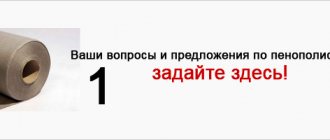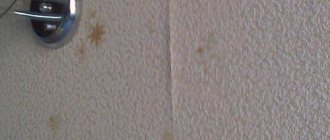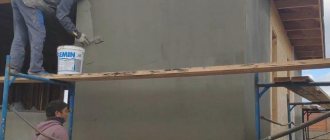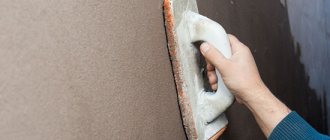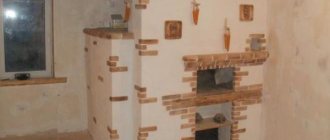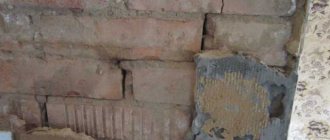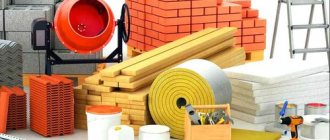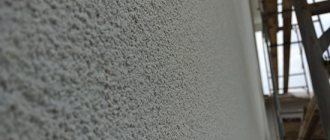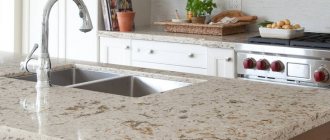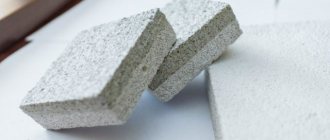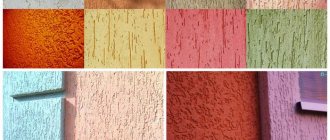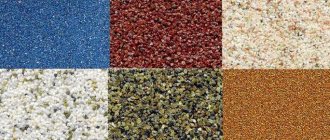Plaster is a layer of artificial stone on the surfaces of various structures of buildings and structures (walls, partitions, ceilings, columns, etc.), which serves for their finishing and in some cases performs special functions.
Plaster is divided into two types - monolithic and dry.
Dry plaster is the covering of surfaces with sheets of industrial production. The installation of dry plaster is allowed in all rooms where the air humidity under operating conditions does not exceed 60%.
Monolithic plaster is applied to the surface of the plaster mortar to be finished. Monolithic plaster differs in purpose, quality of workmanship, type of binder mortar and application technology.
Depending on the method of processing the front layer, monolithic plasters are divided into ordinary and decorative.
Conventional plasters are intended for subsequent wallpapering or painting with various compositions.
Decorative plasters are independent colored or textured facing layers. Of the decorative plasters, the most common are colored lime-sand, stone, terrazite, less often - marbled, sgraffito, etc.
Depending on the class of the building and its purpose, different quality requirements are imposed on monolithic plaster.
She may be:
- simple (under the falcon) - in warehouses, basements;
- improved (as a rule) – in residential, civil and industrial buildings;
- high quality (for lighthouses) – in public buildings.
Simple plaster consists of two layers - spray and primer (plaster coating); thickness of the plaster coating is up to 12 mm.
Improved plaster - a spray layer, one layer of primer and a covering layer; thickness of the plaster coating is up to 15 mm.
High-quality plaster consists of a spray layer, two or three layers of primer, a covering layer or a decorative layer, followed by texture; thickness of the plaster coating is up to 20 mm.
Spray is the first layer of plaster coating, the purpose of which is to ensure adhesion of the coating to the surface being finished. In view of this, a solution with a cone draft of 9–14 cm is used for spraying. The thickness of the spray layer on wooden surfaces is no more than 9 mm (including the thickness of the shingled upholstery); on stone, concrete and brick no more than 5 mm.
Soil is the main (by volume) layer of the plaster coating. It forms the required thickness of the plaster and levels the surface. The thickness of the soil layer should not exceed 7 mm for lime and lime-gypsum mortars and 5 mm for cement mortars.
The covering layer serves to prepare the surface to be finished for painting. A sufficient layer thickness of 2 mm.
To finish surfaces that are subject to specific requirements during operation, special plasters (waterproofing, acoustic, X-ray protective) are used.
Types of plastering work
Preparatory work when processing new buildings and when renovating premises always begins with plastering the walls and ceilings, which is the initial stage of finishing the premises. This includes applying a layer of plaster to various surfaces of walls, ceilings and facades in order to level them, increase heat conservation, and protect them from damaging environmental factors. Plastering is a mandatory procedure during repair and finishing work. The durability of the protected surfaces of the building and the plaster itself, as well as its pleasing appearance to the eye, depend on the quality of the plaster mortar and the skill of applying the mortar.
Sealing corners around the perimeter
Work in this area needs to start from the ceiling. A solution of the same consistency is prepared as for the walls, but narrower spatulas are used. The formation of a small overlap on the main part of the surface is not critical: they can be removed in the future with sandpaper. Using this principle, all corners throughout the entire volume of the room are sealed.
When finishing corners, an already finished surface will serve as an example of a plane, and you can ignore the beacons. In this case, you need to use a square to maintain the perpendicularity of the corners.
At the end of the work, it is necessary to check the surface for cracks. If they occur, you need to seal them with a more liquid solution. If differences of more than one millimeter are formed, they are removed with the sharp edge of a trowel. Only then can the beacons be finally removed and the resulting gaps sealed with mortar. The final treatment involves sanding. When working with gypsum plaster, no finishing is required. At this point the finishing work is completed. It remains to wait until the applied solution dries and gains hardness.
Choosing plaster material
The types and purposes of plaster can be divided into two main types.
They are different in faction and characteristics:
| For external surfaces | This option has a large fraction and is intended for finishing external surfaces. Perfectly tolerates moisture and temperature changes. |
| For interior work | This type has a fine fraction. With its help it is quite possible to create a smooth and even surface. But it is not resistant to external influences. |
The purpose and types of plaster are also divided according to their functionality.
Heat-protective
It is also called “warm” (see Warm plaster: composition and features of use), it is used when finishing the facades and interiors of buildings to improve their thermal properties.
- The basis of this plaster is a cement-sand mortar. The addition of insulating fillers into its composition: perlite sand, vermiculite, polystyrene foam, granulated foam glass, qualitatively changes the properties of the solution.
- All ingredients are quite light in weight and have a low density. When finishing the surface with plasters containing these materials, it is possible to reduce the load on the foundation.
- In addition, with such a finish it is quite possible to abandon the external insulation made of mineral wool boards or expanded polystyrene.
- This type of plaster provides not only heat-protective properties. It contains mineral fillers, which classify it as a non-combustible material (with the exception of the composition with polystyrene foam).
Acoustic
This plaster provides sound insulation in production workshops of industrial enterprises; it is used to reduce noise in offices of public buildings, restaurants, and cafes.
Attention: It is often used in the decoration of residential premises to reduce noise levels by plastering walls and ceilings.
- Acoustic plaster is based on cement or gypsum. Its fillers can be crushed slag pumice, expanded clay, vermiculite or volcanic glass, which give it sound-absorbing properties due to its relatively low density.
- To increase sound absorption, aluminum powder is added to the mixture, which makes the plaster more porous. The applied solution should not be rubbed, so that the voids in the filler do not become clogged with the base.
- Acoustic plaster can be applied to any base that is previously primed with cement-sand mortar (1:2) with the addition of lime (10%).
- It is not advisable to apply painting or whitewashing to this type of plaster, as this reduces the level of sound absorption.
Waterproofing
New types of high-density plaster are used to form a coating and simultaneously level the surface of the structure.
- Plaster mixtures contain water repellents, thanks to which the material does not absorb water, making the coating completely waterproof.
- Most often they contain polymers - epoxy, acrylic and polyurethane resins. Such a covering must be installed in fountains, pools, cellars, basements, partially or completely buried in the ground. It protects structures from penetration of groundwater, high humidity, and can withstand the pressure of a water column 5 meters high.
- Two types of waterproofing plaster have found application: cement-sand and asphalt. In the production of cement-sand plaster, aluminosilicates, finely ground coal and stone flour, bitumen, etc. are used as sealing additives.
- The mixtures necessarily contain plasticizers: adisol-mylonafte, ordinary sodium oleate or sodium palmitate, which give it hydrophobic characteristics. There is a mechanized way to protect structures - layer-by-layer shotcreting under pressure using a cement gun.
- Asphalt plaster is widely used in waterproofing building elements. The composition of hot plaster includes road grade bitumen, polymer additives (crumb rubber, latex), fillers and sand. Before applying it, it is necessary to prepare the base: make notches, clean, dry, prime.
- Asphalt plaster can be applied manually or using an asphalt thrower, which greatly speeds up the plastering process. Cold asphalt plaster is a lime-bitumen paste with the addition of Portland cement, latex, and brick powder. The mixture is applied in layers from bottom to top. To protect against mechanical damage, the plaster is protected with a cement screed, panel formwork, etc.
Special plaster
There are also types of plaster for special purposes. Its price is significantly higher than conventional material. This surface finishing is used for highly specialized purposes, when certain protective properties are required from the room: from X-rays or from exposure to external aggressive conditions (acids, etc.).
It is usually used for finishing industrial buildings, medical institutions and chemical laboratories. When designing a construction project, those rooms that must be finished with special solutions are determined in advance. The drawings indicate the names of the compositions and areas of plastering, the amount of materials used, and the estimates include all the necessary costs.
- X-ray protective plaster mixture used in rooms with sources of ionizing radiation. Its main filler is ground barite concentrate (barium sulfate). The thickness of the plaster layer is pre-calculated in the laboratory; it must correspond to the degree of radiation of the installations. The use of barite plaster is more economical than finishing with lead screens, therefore it is widespread. Work is carried out at a temperature of +15-20°C and normal air humidity. If the layer thickness exceeds 30 mm, then the plaster layer is applied over a mesh fixed to the base. With a design thickness of more than 50 mm, it is more advisable to use barite slabs as finishing.
- Acid-resistant plaster is most often used in the finishing of buildings and structures exposed to gaseous aggressive environments. In its composition, it has a complex combination of quartz sand (as a filler), liquid glass (potassium or sodium), acid-resistant cement and a sodium silicofluoride hardener for hardening the solution. The top surface of the acid-resistant plaster is covered with a cement-sand mortar. This will protect the layer from the destructive effects of air.
- Fireproof plaster is resistant to temperatures up to +200°C, it can contain a fire for two hours. Heat-resistant fire-retardant plaster mixture is used for finishing internal surfaces in enterprises where flammable materials and high temperatures are used, for finishing stoves in industrial production, as well as home fireplaces. It can reduce fire damage to a minimum and has recently become often used in the decoration of private houses, baths, and saunas. Fireproof plaster mixture is made on the basis of kaolin clay, fireclay dust and liquid glass. The plaster must be applied to a dust-free, solvent-free, or primed base manually or using a cement gun. The main thing when working with such material is that the finished solution is produced within 30 minutes, and the strips applied to the surface overlap each other to avoid the appearance of seams.
Attention: When purchasing special plasters, the instructions must be studied. After all, you can’t always apply it yourself, and its specialization is quite narrow.
Decorative
Decorative plasters (see What types of decorative plaster exist) are based on cement-lime, silicate, silicone and polymer compositions. As a filler, there are various additives in the form of mica, stone chips, fragments of shell rock, and wood fibers.
Simple
Simple plaster (PS) is applied in one layer with or without rubbing. Grinding is carried out without applying an additional layer of fresh mortar using polyurethane or foam floats. No splashing or covering.
At construction sites, the material used is a lime-cement mixture; when renovating apartments, it is replaced with any mortar suitable for the premises, taking into account its characteristics. Do not think that PS is a rough smearing of mortar on the wall “just so that the bricks are not visible.” Deviations when checking the accuracy of work with a two-meter level are a maximum of 4 mm, and along the height of the wall, clearances do not exceed 7 mm.
This type of plaster is used for:
- Preparing walls for laying tiles,
- Leveling surfaces in utility rooms and basements,
- Protection of the foundation and facade from external influences.
Beacons are not used in the work; the solution is applied with a trowel, a trowel or from a station hose, and the base is leveled using a plaster rule. Layer thickness up to 2 cm.
When leveling walls in damp rooms, cement is added to the plaster, regardless of the type.
Which one to choose?
For reliable operation and long service life of the coating, it is worth paying attention to the choice of plaster, which is better than others when finishing a particular type of surface.
When plastering walls made of aerated concrete, the main thing is not to clog the pores , as this will lead to a violation of vapor permeability. Therefore, cement-sand mortar is not suitable here.
Aerated concrete is best finished with gypsum-based plaster mixtures. The finished layer allows water vapor to pass through it well, providing good vapor permeability.
Although aerated silicate blocks are made using a slightly different technology than aerated concrete, they have a cellular structure similar to it. gypsum plaster is also suitable for finishing it , in particular it can be lime-gypsum dry plaster.
Mixtures for finishing walls made of foam blocks differ from the compositions used for brick and other types of surfaces. The main parameters that plaster for foam blocks should have are light weight and good adhesion. Ready-made cement plasters are suitable here (for example, Ш-36 “Decor” or “CeresitCT24”).
For woodworking, you can use homemade solutions based on various binders - clay, lime, cement. The first two materials are rarely used today, despite the fact that they have high thermal insulation characteristics and antiseptic properties.
It is also possible to use construction putties (both starting and finishing), but this is a more expensive option.
For plastering over insulation, in particular, we will consider penoplex. The best plaster for this material is gypsum. Knauf Rotband mixtures and Fugenfueller universal plaster have proven themselves well. Plastering is performed using reinforcing mesh .
Classification - different types
There are several classifications that are based both on the components included in the composition, the type of base, and the scope of application.
Decorative plasters, depending on the conditions used, are divided into external (facade) and internal (interior).
Using a facade type is an excellent way to decorate a building.
Its main advantages include the fact that this material is not exposed to moisture, is resistant to temperature changes and changes in weather conditions. It serves as an excellent heat insulator and sound insulator.
It is impossible not to note the strength. In addition, with its help you can create a unique look for the building. The designs and textures are varied, they depend only on your imagination and financial capabilities. You can make the finish either plain or painted. Let us note that the price is much cheaper than other finishing products, which is nothing to please!
Interior decorative plaster is rising higher and higher on the construction Olympus every year. First of all, this is an environmentally friendly material that will not negatively affect your health.
It can be used even if you have children or family members with allergies. This type allows you to hide minor imperfections in the wall. It is much more reliable and durable than the same wallpaper. If you have a cat at home, then you will appreciate this finish.
Now you don't have to worry about claw marks on the walls. This wall is easy to clean. It is acceptable to use both dry and wet cleaning. It has high water-repellent properties. Therefore, if you want to wipe the wall with a damp cloth, you don’t have to worry about the surface becoming dull or deformed.
Let's consider a classification based on composition. It is divided into four classes:
- Mineral;
- Polymer;
- Silicone;
- Silicate.
The basis of mineral plaster is cement-lime or cement mortar. It can be used for both interior and exterior work. This class has high vapor permeability.
Thanks to this property, the building can breathe and condensation will not form on the walls. The introduction of lime into the composition makes the mass more plastic. It is also worth noting that this component allows you to regulate the humidity in the room.
Since it absorbs moisture from the room, but does not violate its internal structure. Mineral becomes more durable over the years.
This class allows you to create a relief surface. It can add texture to a home. It can be painted in the desired color or left with a natural nobility of shade.
Polymer plaster is made on the basis of acrylic resins, hence its second name. It does not fade in the sun, temperature changes and high humidity are also not scary for it.
This is an ideal option for both facade finishing and interior work. This finish forms a thin layer on the wall. Thanks to the fillers included in its composition, you can recreate the noble texture of leather or marble.
If you decide to use it for outdoor work, then remember that it is not recommended to use loose insulation (for example, mineral wool), since it is vapor permeable.
Silicone plaster is far from a budget option . It does not need to be diluted, as it is sold ready-made. The basis is silicone resins.
This option allows you to add the smallest fillers to the composition. You can add quartz sand or marble dust. It can be used for both interior and exterior work.
Its main advantage is durability. If you want to forget about repairs for a long time, then this is the ideal option for you. Let us also note its property of self-cleaning from dust. If you use it to decorate a building, then rainwater and wind will keep the façade clean!
Silicate plaster is somewhat similar in properties to mineral plaster , but much stronger. It is sold ready-made. The binder of this class is liquid glass.
A large selection of colors allows you to choose any color to suit your taste. It can also be used for outdoor work, but the base should be a composition based on quartz sand.
Necessary tool
Depending on the type of surface (concrete, brick, aerated concrete or wood), the master must have a set of tools for the job.
- You will need a portable ladder or platform that is convenient to climb onto to process high sections of the wall.
- The old coating is removed by tapping with a hammer. A chisel, brushes, and a set of spatulas may be useful. With these tools you can remove all layers of the old coating down to the very base.
- In hard-to-reach places, use a hammer drill with attachments. Remains of plaster are removed with a metal brush. Advice A good assistant is an electric drill or grinder. When working with these tools, it is advisable to prepare bags for garbage, as there will be a lot of it.
- You will need an extension cord when working with power tools.
- It is good to scrape off the lagging layer of wallpaper or plaster with a spatula. If it is thin, it is easier to pick it up with a paint brush dipped under water.
- Sometimes you may need a sander or a vacuum cleaner to use a hose to collect all the wall dust.
- You need a container for mixing the solution, rollers with different attachments, a trowel, a regular knife, a blade, rags for wiping away stains, masking tape for sealing corners and baseboards.
Features of machine plastering walls
Mechanized plastering makes work easier, speeds up the process and saves money. The specialist is assisted by a mobile plastering station, which takes on half the work. The master is required to load the mixture into the unit and apply it to the wall. Leveling and quality control are also the responsibilities of the plasterer. The station’s “competence” includes labor-intensive mixing of the solution to the required consistency and supply of the mixture.
Material savings are achieved due to the specific mixing. During the mixing process, the solution is saturated with air - with the same mass it comes out more voluminous. Machine finishing leads to an average saving of 5-6 kg of dry mix per each plastered square meter. The result of mechanized processing is a coating that does not require subsequent puttying.
Additional advantages of the machine method:
high speed - finishing with plaster is performed 3-5 times faster;
high adhesion of the solution to the wall surface; the reason for better adhesion is the characteristics of the composition and the uniform application of the mixture to the base;
durable coating that does not tend to peel off or crack.
High quality
The main difference between high-quality plaster (HS) and improved plaster is the accuracy of the work. The number and thickness of layers are the same, except that for VS an increase in the total thickness of the mantle by 5 mm is allowed. A deviation of 2 mm per 2 meters of wall height/length or 3 mm over the entire height is acceptable. These are limiting values; in modern construction, deviations are within 1 mm.
Such precision of work can be achieved by using beacons for high-quality plastering, which are pre-installed by level and cord (vertical and horizontal accuracy). After the solution has set, the beacons can be removed, but in practice this is rarely done, since the labor costs for dismantling and sealing the seams exceed the savings on consumables.
High-quality plaster is the standard for leveling walls, so classic lime mixture is rarely used for work; it is replaced with dry mortars with polymer additives.
Grinding of VS is done with metal spatulas and half-graters, less often with classic graters, including those with glued felt.
Complete list of permissible deviations according to SNIP.
Types of special plasters
Depending on the functional features, certain groups of plaster coatings are distinguished:
Heat-protective plaster
Otherwise called “warm”. It is used for thermal insulation of the entire room as a whole or its individual communications. The main structural element is a cement-sand mass. To impart heat-saving and insulating properties, various fillers are added: foam glass, vermiculite, expanded perlite, polystyrene foam and others.
The peculiarity of the mixture is its “lightness”, since all components, in addition to low density, are light in weight. Therefore, the plaster mixture, even with a fairly thick layer, does not add any special load to the walls, while creating comfortable microclimatic conditions.
Thermal insulating plaster is very popular in private housing construction. Its use for internal insulation eliminates the need to create an additional insulating layer on the outside.
It is characterized not only by heat-protective, but also by fire-resistant parameters due to the presence of mineral fillers in the composition.
Waterproofing plaster
Its composition is completely waterproof due to the addition of water repellents, making the material 100% waterproof. The waterproof polymers it contains are usually resins of polyurethane, epoxy and acrylic origin.
The role of the main structural component in such plaster mixtures can be played by a cement-sand or asphalt mixture, which was the reason for grading waterproofing compounds into two types:
- Cement-sand, characterized by the presence of aluminosilicate, bitumen and coal-tar sealing additives mixed with plasticizers.
- Asphalt plaster for special purposes, which, in turn, is divided into two more groups:
- A “hot” mixture containing bitumen, sand, filling agents, as well as polymer additives, in particular crumb rubber or latex.
- “Cold” mixture, which is a lime-bitumen mass mixed with cement, fine brick chips and latex.
Waterproofing plaster, the composition of which can be strengthened by applying it with a cement gun, will have an even greater degree of water resistance.
Soundproofing plaster
It is widely used for finishing home, office and industrial premises. The basis is a gypsum-cement mixture, supplemented with crushed slag pumice, vermiculite, expanded clay or other fillers that increase the sound-absorbing properties of the composition.
In order to increase the soundproofing characteristics, a unique aluminum powder is added to the mass, making the material more “airy” and porous.
Most often, acoustic plaster is used to decorate rooms with many curved or curved shapes, traditionally created on the ceiling, which allows replacing expensive suspended sound-absorbing structures.
However, its use for subsequent painting is highly not recommended, since this will lead to a decrease in the level of protection from extraneous noise.
Highly specialized plasters
The following types of special plasters are used for highly specialized purposes. Their scope of application is medical institutions, chemical laboratories, industrial/production workshops, etc.
X-ray protective barite plaster
It has found its application for finishing work in rooms and classrooms characterized by the presence of sources of X-ray radiation. That is, the composition is intended to create a protective barrier on surfaces from any type of ionizing radiation that exceeds regulatory limits.
The main components are barite sand and barite concentrate, which help block penetrating radiation. The composition may be:
- barite-concrete (cement), produced on the basis of barite-hammer concentrate;
- magnesia-barite, the function of the main active ingredient in which is performed by a high-quality component with the highest possible content of pure barium.
X-ray protective barite plaster is an excellent way to save on expensive lead screens without losing performance properties and the ability to eliminate ionizing radiation.
The thickness of the application of the finished mass can reach 5 cm. To make the layer more massive, it is possible to use barite slabs.
Acid resistant plaster
Such special plasters have a complex composition, which includes:
- Fine quartz sand serving as a filler,
- Potassium or soda glass,
- Hardener made from sodium fluoride silico,
- Acid-resistant cement suspension.
Additionally, the mixture can be refined with quartzite or stone flour. Acid-resistant plaster is suitable for use in workshops at chemical enterprises, large laboratory centers and industrial enterprises or in other structures associated with contact of gaseous aggressive substances.
A special feature of applying plaster is its covering with a cement-sand mixture, designed to protect liquid glass from destruction under the influence of air, which is subsequently rubbed down with cement milk.
Fireproof plaster
It is made on the basis of potassium or sodium glass, fireclay dust, and kaolin clay.
Heat-resistant mixtures have found their use in finishing surfaces located in industries that use flammable and lubricating liquids with constant contact with high temperatures, as well as in finishing interior fireplaces, home and industrial stoves. An excellent option for saunas, steam rooms and baths.
The advantage of the material is its resistance to the highest temperatures, reaching +200°C. Fire-resistant plaster can contain fire for at least 2 hours.
When choosing special plasters, you should remember that their use is only appropriate for certain rooms. The mixing must be carried out with pinpoint precision according to the instructions, and installation is best left to professionals, because the functionality of the composition will depend on the quality of preparation and finishing.
At the stage of wall finishing it is very difficult to do without plaster, so it is worth knowing exactly what coatings exist and their main features.
Dry
For indoor use. To prepare a layer of dry plaster, plasterboard sheets are used. They are great for leveling walls, and due to their ease of installation they are in great demand. Used only for arranging walls indoors. It is most often used when it is necessary to complete work in a short time, so there is no need to wait for hardening.
For installation, a metal frame is used, preferably a galvanized profile is used. It is attached to the wall using brackets or screws, and is additionally fixed to the ceiling and floor.
